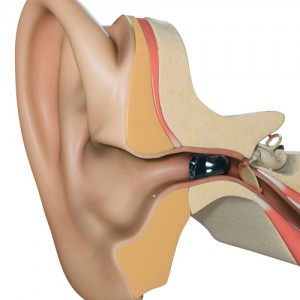Sound is first focused into the ear canal by the cup-shaped outer ear. For us to hear, sound waves must first enter the ear canal and vibrate the ear drum. These sound vibrations are then transmitted by three tiny bones or ossicles (the malleus, incus and stapes), through an air filled middle ear space to get to the inner ear (cochlea). The vibrations then travel through a fluid within the inner ear and stimulate nerve endings (hair cells) in the snail shaped cochlea. The nerve endings create electrical impulses which are then carried through the inner ear nerve (cochlear nerve) to get to the brain. A hearing loss may be caused by any obstruction of the ear canal, abnormality of the ear drum, fluid in the middle ear space, problem with the middle ear bones, or abnormality of the inner ear nerve fibers.
 The outer ear includes the part of the ear that sticks out from the head and the ear canal extending down to the ear drum (tympanic membrane). Ear wax (cerumen) is made by the outer half of the ear canal. Cerumen moisturizes the ear canal and helps prevent outer ear infections.
The outer ear includes the part of the ear that sticks out from the head and the ear canal extending down to the ear drum (tympanic membrane). Ear wax (cerumen) is made by the outer half of the ear canal. Cerumen moisturizes the ear canal and helps prevent outer ear infections.
The middle ear is the air filled space from the ear drum to the inner ear. The three middle ear bones (malleus, incus and stapes) transmit vibration through this space. The air in the middle ear comes from a small tube, about an inch long, called the Eustachian tube. The Eustachian tube runs from the middle ear space to the back of the nose, just behind the sinuses and acts as a pressure equalizer. If the eardrum has pressure on either side of it, it cannot vibrate effectively and you can’t hear very well. The Eustachian tube opens up every time we swallow, letting air into the middle ear space, equalizing pressure, and draining any fluid which may accumulate
The inner ear includes the cochlea and the three semicircular canals. The cochlea is a fluid-containing chamber shaped like a snail shell, which contains sensitive nerve fibers (hair cells) which convert vibrational sound energy into electrical nerve energy. The electrical impulses are transmitted to the brain by the auditory nerve.
Another important function of the inner ear has to do with balance. Inside the inner ear, is the vestibular labyrinth. It consists of three semicircular canals that give us our sense of balance. They are the horizontal, anterior and posterior canals. The nerve fibers in the semicircular canals also contain fluids and sensitive nerve fibers, which respond to head position and movement. A very common and treatable form of dizziness called Benign Paroxysmal Positioning Vertigo (BPPV), involves a malfunction in the posterior semicircular canal.
